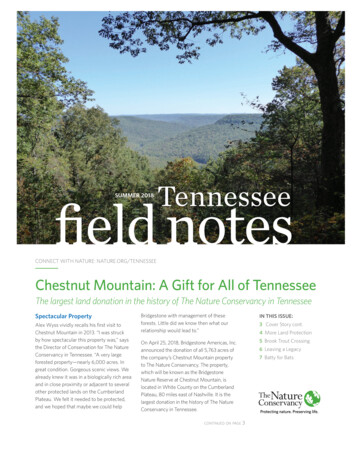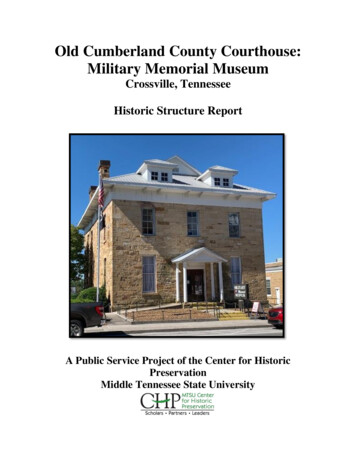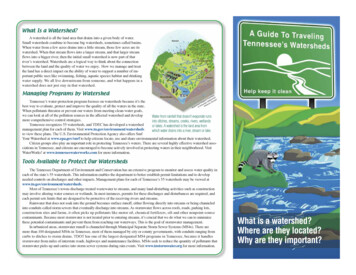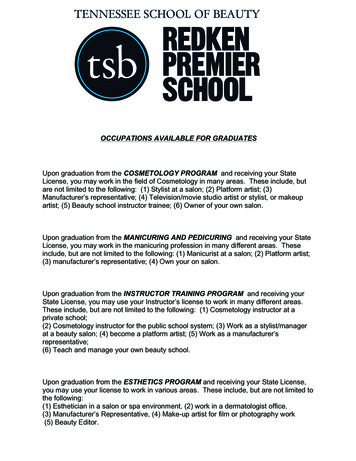
Transcription
Tennesseefield notesSUMMER 2018CONNECT WITH NATURE: NATURE.ORG/TENNESSEEChestnut Mountain: A Gift for All of TennesseeThe largest land donation in the history of The Nature Conservancy in TennesseeSpectacular PropertyAlex Wyss vividly recalls his first visit toChestnut Mountain in 2013. “I was struckby how spectacular this property was,” saysthe Director of Conservation for The NatureConservancy in Tennessee. “A very largeforested property—nearly 6,000 acres. Ingreat condition. Gorgeous scenic views. Wealready knew it was in a biologically rich areaand in close proximity or adjacent to severalother protected lands on the CumberlandPlateau. We felt it needed to be protected,and we hoped that maybe we could helpBridgestone with management of theseforests. Little did we know then what ourrelationship would lead to.”IN THIS ISSUE:On April 25, 2018, Bridgestone Americas, Inc.announced the donation of all 5,763 acres ofthe company’s Chestnut Mountain propertyto The Nature Conservancy. The property,which will be known as the BridgestoneNature Reserve at Chestnut Mountain, islocated in White County on the CumberlandPlateau, 80 miles east of Nashville. It is thelargest donation in the history of The NatureConservancy in Tennessee.5 Brook Trout Crossingcontinued on page3 Cover Story cont.4 More Land Protection6 Leaving a Legacy7 Batty for Bats3
FROM THE DIRECTORBOARD OF TRUSTEESChair, Mary JohnsonTara ArmisteadKeith AulsonLisa CalfeeState Director’s ChatEdgar FaustAs many of you know, The Nature Conservancy has acquired andprotected many important landscapes in Tennessee during our 40-yearhistory in the state. We’re over 335,000 acres now, and growing.That’s the equivalent of 397 New York Central Parks—or 250,000football fields. But more important than the quantity of acres is thequality, because we’ve protected landscapes that are special forpeople and provide crucial habitat for wildlife and plant species.Caren GabrielJay GulledgeWhitfield HamiltonRobert JohnstonCarolyn LongLuther MercerSharon M. PryseHolt ShoafEmma WilliamsSTAFFTerry Cook, State DirectorRob BullardJeff ForeCorey GilesJed GrubbsBrittany HobackCory HollidayTrish JohnsonPaul KingsburyGabby LynchCharles McQueenHelen McQueenKenneth McQueenKatherine MedlockBritt MosesSally PalmerKatie PareigisBrad ShaverJoey WisbyAlex WyssThe Nature Conservancy isa private, nonprofit 501(c)(3) international membershiporganization.Over the past four decades, we’ve helped protect and expand some ofTennessee’s most treasured places. Radnor Lake. Savage Gulf. The Wallsof Jericho. Frozen Head State Park. Pogue Creek Canyon. The Tennessee River Gorge. The DuckRiver. The Hatchie River. The Obed Wild and Scenic River. All told, the Conservancy has created orexpanded 29 State Natural Areas, 13 Wildlife Management Areas and 3 National Wildlife Refugesin Tennessee.Now, through the generosity of Bridgestone Americas Inc., we can add Chestnut Mountain to thelist of special places we are protecting. Currently, we are developing a management plan for theBridgestone Nature Reserve. Several things are high on our list of priorities, including: Carbon sequestrationEnhanced forest managementThe restoration of shortleaf pine and grassland habitats where appropriateInvolvement of local universities in research and biological inventoriesAnd also public access and recreation.Our intention is to make the Bridgestone Nature Reserve accessible to the local White Countycommunity and general public for low-impact activities such as hiking, birding, educational programsand more. We’re also interested in working with the state and other conservation groups to developand improve trail connectivity between the 60,000 acres of public lands in this area. By improvingopportunities for ecotourism, we hope to boost the local economy.Ultimately, by working with our state agency partners and other conservation organizations, we hopeto bring more attention to and support for conservation of this entire area of the Cumberland Plateau.We’re formulating plans for a Conservancy members day with our staff at this beautiful placesometime this fall. Stay tuned to our emails, website and social media. We’re looking forward tosharing this spectacular place with you.See you outside,The Nature Conservancy’s missionis to conserve the lands and waterson which all life depends.Terry Cook, State DirectorP.S.: If you haven’t done so already, please consider a gift to Tennessee above and beyond yourannual membership. That support enables us to enhance our programs, especially at the newBridgestone Nature Reserve at Chestnut Mountain. Our fiscal year ends June 30.
CONTINUED FROM THE COVERTNC will manage a carbon sequestrationproject on the property that will offsetthe carbon emissions of the BridgestoneTower, the company’s corporateheadquarters in downtown Nashville, foryears to come.“We applaud Bridgestone for itscommitment to the environment,” saysTerry Cook, State Director for The NatureConservancy in Tennessee. “We arehonored that Bridgestone has entrustedThe Nature Conservancy with themanagement of this important forest.”The property’s namesake, ChestnutMountain, is the highest peak in WhiteCounty, with an elevation of about 2,000feet. The nature preserve includes mixedhardwood and pine forests, woodedmountain gulfs, caves, the headwatersof the Caney Fork River, and Billy BranchLake, which provides drinking water forcommunities in the area.A Haven for Rare SpeciesThe Firestone tire company had acquiredthe property in the early 1970s as apotential corporate retreat, and whenBridgestone acquired Firestone in 1988it kept the property undeveloped andprotected. That was fortunate and farsighted. The Bridgestone Nature Reserveat Chestnut Mountain provides habitatto more than 100 species of conservationconcern, including the golden eagle, theEastern slender glass lizard, the barkingtree frog and the green salamander. Thearea is also known habitat for turkey, quail,deer, bobcat, red and gray foxes and beaver.In addition, the property is part of a mosaicof 60,000 acres protected public landson the Cumberland Plateau that includesVirgin Falls State Natural Area, Fall CreekFalls State Park, Bledsoe State Forest andthe 10,000-acre Bridgestone/FirestoneCentennial Wilderness, which Bridgestonedonated to the state of Tennessee inThe nature preserve includes mixed hardwood and pineforests, wooded mountain gulfs, caves, the headwatersof the Caney Fork River, and Billy Branch Lake, whichprovides drinking water for communities in the area.1998-2000 as a wildlife management area.Plans for the Bridgestone Nature Reserveinclude low-impact public access andthe creation of connector trails betweenChestnut Mountain and the otherprotected lands in the area. The NatureConservancy will develop a master planfor public access first. These actions canhelp ecotourism and provide a positiveeconomic impact to the area.Outgrowth of CollaborationThe property donation is a naturaloutgrowth of a collaboration betweenBridgestone and TNC. In 2014, the twoorganizations began working togetheron a comprehensive forest managementplan for the property, which has includedprotective treatments for its hemlock treesto fight the hemlock woolly adelgid pestand restoration of native shortleaf pinestands on selected areas. In the Southeast,shortleaf pine forests have declined bymore than 50 percent in the past 30 years.Restoring these trees will help re-establishhabitat for ground-nesting birds likebobwhite quail and other species.COVER: View along the gorge from Chestnut Mountain. Paul Kingsbury/The Nature ConservancyABOVE: Billy Branch Lake. Paul Kingsbury/The Nature ConservancyWith the help of TNC, Bridgestone hadenrolled the property in Forest StewardshipCouncil certification, one of the higheststandards of forest management forsustainable forest products. Plans for theproperty include sustainable managementof the forest in addition to the carbonsequestration program.“Prior to our involvement, this forest hadnot seen much disturbance in terms offire or active management,” says TrishJohnson, Director of Forest Protection forTNC in Tennessee. “Active managementof this forest will strengthen its overallhealth and resilience to climate change.It also provides a great opportunity to doshortleaf pine restoration.”“If we had first visited this property adecade ago, we might have said simply,‘Great forest! Big trees! Let’s just leave italone and protect it,’” says Alex Wyss. “Butin recent years, conservation science hasshown that sometimes forests like thishave lost key components, especially withan over-suppression of natural fires. Pineoak woodlands and savannahs with nativegrasses and wildflowers are native habitatsNATURE.ORG/TENNESSEE 3
CONTINUED FROM PREVIOUS PAGEthat we have lost in many placesbut that we can bring back. Makeno mistake: Chestnut Mountain haslots of healthy forest, but it doesn’thave all the species that should bethere. We can help that.”Trish Johnson also thinks it’ssignificant that the natural splendorof Chestnut Mountain will no longerbe a well-kept secret: “I suspect thatwhen Firestone bought this propertyin the 1970s, they recognized thebeauty of this landscape and wantedto preserve it. That was a good thing.But now all the citizens of Tennesseewill be able to enjoy it. And that’seven better. The vision for thisproperty has changed, and for thebetter for everybody.”LAND PROTECTION UPDATEIn addition to the donation of ChestnutMountain, we continue to be very activein pursuing other key land purchases toprotect ecologically important areas.Rhea County/Spring CityOur first land acquisition ever in RheaCounty was a beauty! In May, wepurchased 377 acres on Walden Ridge,overlooking the scenic Piney River gorge.This beautiful property, located justnorth of Watts Bar Lake, is close to theCumberland Trail State Park and SoakCreek, a State Scenic River.Even better, this Piney River tract isadjacent to Piney Falls State NaturalArea. That fact was a key motivationto acquire the property when it cameon the market. Our plan is to transferthis now-protected land to the state ofTennessee, which will almost double the4 TENNESSEE FIELD NOTES 2018 SUMMERsize of Piney Falls State Natural Area tomore than 800 acres.JacksonIn the Winter 2017 issue of Field Notes,we reported on the new, multi-usenature park that is being planned forJackson, Tennessee. It will have milesof trails for walking, jogging and biking,and access for paddlers and anglers.When we last reported on it, we hadacquired 858 acres along the MiddleFork of the Forked Deer River. Now wehave purchased an additional 287 acres,bringing the grand total of acreagefor the park to 1,145. We’re grateful tothe Tennessee Heritage ConservationTrust Fund and the Tennessee WildlifeResources Agency’s U. A. MooreWetlands Acquisition Fund for makingthis project possible. The park’s plan iscurrently under development with keypartners, including the West TennesseeRiver Basin Authority, the TennesseeWildlife Resources Agency, theTennessee Department of Environmentand Conservation and other partners.Obed RiverOur longtime relationship with a familyin Morgan County helped facilitate awonderful land donation to the NationalPark Service, expanding the protectedlands of the Obed Wild and ScenicRiver corridor. In February, the Gibbonsfamily donated 161 acres along the gorgeof the Obed River to the Park Service.This property had long been a highpriority acquisition for the Obed Wildand Scenic River, because if bluff-topdevelopment occurred here, a longstretch the Obed’s famous wildernessview would have been irreparablymarred. We were proud to assist withthe donation to protect this special area.
RESTORATIONHelping the Brook Trout Cross the RoadIn the mountains of East Tennessee,aquatic animals like the SouthernAppalachian brook trout often sufferwhen road construction, logging andother development affect the mountainstreams they call home. Last fall, TheNature Conservancy and an allianceof agencies and nonprofits bandedtogether to address a problematic roadcrossing and keep a mountain stream inthe Cherokee National Forest safe forbrook trout and other fish.Tennessee’s only native trout species—the brook trout—suffered severedeclines in the last century, mostlythrough human actions. Pollution,overfishing and the introduction ofthe non-native rainbow trout all took aheavy toll on the species. Although theTennessee Wildlife Resources Agency,the Tennessee Valley Authority andother agencies have been reintroducingthis fish to Tennessee’s Appalachianmountain streams, the brook trout stillneeds help.This was certainly the case at BriarCreek (a tributary of the NolichuckyRiver) in the Cherokee National Forestin Unicoi County. The problem: aroad across Briar Creek had a culvertunderneath that was never intended tobe a fish passage. The old concrete boxculvert that had been installed yearsago wasn’t designed to do anything butmove the creek’s water underneath theroad. Because the base of the culvertwas a smooth concrete pad, streamwater passing through it moved toofast and finished with a waterfall-likedrop-off into Briar Creek. It proved tobe an impasse for brook trout as wellas many other fish. They couldn’t swimupstream past the culvert, weakeningtheir populations.Fortunately, The Nature Conservancy,Tennessee’s only native trout species—thebrook trout—suffered severe declines in the lastcentury, mostly through human actions.the U.S. Forest Service, the TennesseeValley Authority, the Tennessee WildlifeResources Agency, Trout Unlimited,American Rivers and the U.S. Fish andWildlife Service joined forces to solvethis problem.Together, we generated the necessaryfunds and removed the old culvert andinstalled a new one designed accordingto the U.S. Fish and Wildlife Service’sstate-of-the-art Aquatic OrganismPassage techniques. The new culverthas more of a gentle, stair-step inclineand a natural, rocky streambed.“With the old structure, the streamhad been forced through the culvert,”said Ali Reddington, hydrologist withthe U.S. Forest Service. “With this newstructure, we have restored the streamall the way through the road crossingand put a lid on top of it. It now mimicsThe partners gathered at Briar Creek project to celebrate its completion. Our own Rob Bullard is 6th from left. Paul Kingsbury/The Nature Conservancya natural stream channel.”“The channel in the new culvert nowmatches the natural streambed ofBriar Creek on either side of the road,”said Rob Bullard, Tennessee andCumberland River program director forThe Nature Conservancy in Tennessee.“It has a couple of benefits over the oldstructure. First, it allows passage ofaquatic organisms. But it also has thecapacity to allow for greater flow duringflood events, which means it’s morestable and will require less maintenancein the long run.”With the new culvert, more than twomiles of stream habitat have now beenopened up for brook trout and other fishspecies. The improvement of habitatshould lead to healthier fish populationsin Briar Creek.NATURE.ORG/TENNESSEE 5
FACES OF CONSERVATIONLeaving a Legacy: Emma WilliamsEven though she has deepTennessee roots, EmmaWilliams brings aninternational perspectiveto The NatureConservancy’s workin Tennessee. That’sbecause the TennesseeChapter board member, anative of England, spent herchildhood in Gloucestershire beforeher family moved to Chattanooga whenshe was entering junior high.“I have really wonderful memories ofbeing a young child and hiking in theLake District. Going back to when I wasvery small, I had hiking boots!” she sayswith a laugh. “At age six, I started ridinghorses, and I’ve ridden continuouslyever since.”Emma found that time in nature becamea true passion for her after takingkayaking and camping trips in highschool. “That was when I really got it,”she says. “We had a teacher who led uswho was passionate about the outdoors,and it was infectious.”Now a marketing andcommunicationsprofessional with herown firm (Full CircleCommunications),Emma was invited to jointhe board of The NatureConservancy in Tennesseein 2013. “It’s funny,” she says, “butit seems like I always knew about TheNature Conservancy—but more as aglobal organization. I really only got toknow our exceptional work in Tennesseewhen I joined the board.“The more I saw and learned, the moreinvested I became. For example, ourTennessee work with cave bats and theirprotection is phenomenal. We havecontributed so much to research in thefight against white-nose syndrome [thefungal disease that is decimating cavebats]. I’m really proud to be a part of anorganization that’s creating opportunitiesfor innovation and working to save a keypopulation of animals.”Recently, Emma’s commitment to TheNature Conservancy led her to includeTNC in her estate plans. That step madeher a member of the Conservancy’sLegacy Club, which celebrates its 25thanniversary this year. “Putting TheNature Conservancy in my will alignswith my values. It simply makes sense tome,” she says.We asked her what she would like to sayto fellow supporters about putting TNCin their estate plans. “I’d say this: Whatis it you want to leave behind as yourlegacy? It’s not about how much moneyyou leave as it is about why or whereyou choose to give. Because if you makethe commitment now, your estate has achance to grow over time. Committingto a legacy gift is not just for peopleapproaching the end of their lives—it’struly for every generation. You’re nevertoo old and you’re never too young tomake this commitment. I’m certainlyglad I did.”TO LEARN MORE ABOUT HOWYOU CAN LEAVE A LEGACY FORFUTURE GENERATIONS, pleasecontact Director of Philanthropy Britt Mosesat britt.moses@tnc.org or (615) 383-9909.Economic Benefits of Open Space for Middle TennesseeMiddle Tennessee’s 10-county area has lost120,000 acres of open, undeveloped space since1999. A recent research report published byCumberland Region Tomorrow quantifies the manyeconomic benefits that natural lands and openspace bring and shares some revealing numbers. a 30,535 average property value increase forMiddle Tennessee homes close to open space.Open space brings 3.2 billion in annual cost savings and economic benefitsthrough ecosystem services: water supply, water filtration,flood control, wildlife habitat, pollination, air pollutionremoval and carbon sequestration. up to 178,000 agriculture & forestry jobs in the10-county region. an average of 1,913 in annual recreational benefitsper household in Middle Tennessee.6 TENNESSEE FIELD NOTES 2018 SUMMER 213.7 million per year in medical cost savings due tophysical activity on Middle Tennessee open space. 325 million of air pollution removal benefits every yearbrought by just the trees in open space.FOR MORE on the report, visitcumberlandregiontomorrow.org.
NEWS & NOTESBatty for Bats!TN H2ONearly 100 people of all agesattended our “Batty for Bats” programat Owl’s Hill Nature Sanctuary inBrentwood on Saturday, May 12. OurTennessee Cave Program Director,Cory Holliday, talked about bats andThe Nature Conservancy’s work toprotect them. Then he led the groupin building their own bat houses outof kits that we provided. Thanks toour friends at Owl’s Hill for hostingthis popular program and to theWallace Research Foundation, whichgenerously funded the bat house kits!Gov. Bill Haslam has assembled stakeholders from federal, state and localagencies, as well as industry, academia, environmental nonprofits andpublic utilities to develop a statewide plan for water use and availability inTennessee. The plan, named TN H2O, will include an assessment of currentwater resources and recommendations to help ensure Tennessee has anabundance of water to support future population and economic growth.Working groups composed of subject matter experts will conduct theresearch and gather the data and information. The Tennessee Department ofEnvironment and Conservation will lead plan development.Our own Director of Science and Policy, Sally Palmer, is co-chairing theNatural Resources Committee of this planning effort. Our West TennesseeProgram Director, Jeff Fore, and our Cave Program Director, Cory Holliday,are also participating on committees. A draft of TN H2O will be submitted tothe governor and made available for public input by October 2018.FOR MORE INFORMATION, -resources/tnh20.html.Help TNC Through AmazonSmileHere’s an easy way to support The Nature Conservancy at no cost to you. Whenever you order something from Amazon, useAmazonSmile. It’s a website operated by Amazon with the same products, prices and shopping features as Amazon.com. The differenceis that when you shop on AmazonSmile, the AmazonSmile Foundation will donate 0.5% of the purchase price of eligible products tothe charitable organization of your choice. The Nature Conservancy is registered with AmazonSmile, and it’s easy to use. Just typeAmazonSmile into your search engine or browser.ABOVE: The Duck River. Byron Jorjorian. RIGHT: Happy bat box builder. Paul Kingsbury/The Nature Conservancy.NATURE.ORG/TENNESSEE 7
The Nature Conservancy in Tennessee210 25th Avenue NorthSuite 810Nashville, TN 37203NONPROFIT ORGUS POSTAGEPAIDNASHVILLE, TNPERMIT NO. 380(615) 383-9909nature.org/TennesseeTennesseefield notesSUMMER N natureTwitter/nature TNBELOW View from Chestnut Mountain overlook. Terry Cook/The Nature ConservancyIN THISISSUEA Gift forAll of TennesseeCELEBRATING 25 YEARS AND 25,000 MEMBERSThank younature.org/legacyContact Britt Moses in Tennessee for information onhow you can leave a legacy for future generations.(615) 383-9909We have some very good news to share with you. In April,Bridgestone Americas, Inc. announced the company’s plansto donate its Chestnut Mountain property in White County toThe Nature Conservancy in Tennessee. Read more inside.britt.moses@tnc.orgTHE NATURE CONSERVANCY CANNOT RENDER TAX OR LEGALADVICE. PLEASE CONSULT YOUR FINANCIAL ADVISOR BEFOREMAKING A GIFT. ILLUSTRATION JIAQI ZHOU. PHOVQ18FY02APGHOXX
NATURE.ORG/TENNESSEE 5 In the mountains of East Tennessee, aquatic animals like the Southern Appalachian brook trout often suffer when road construction, logging and other development affect the mountain streams they call home. Last fall, The Nature Conservancy and an alliance of agencies and










